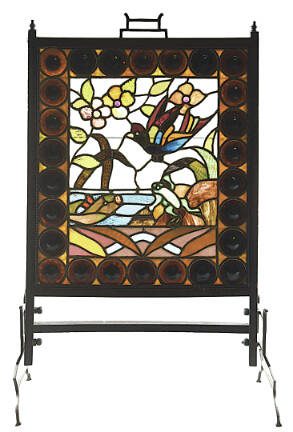Now that we have electric lights and heating, lighting a fire in the fireplace feels like something special. Spend a few minutes in front of one, though, and you’ll remember why technology has moved on. Between the intense heat and light of the flames and the danger of stray sparks, having an open flame indoors isn’t the best idea. That’s where fire screens came in.
By the late 18th century, they were made of various materials such as wood, leather, wicker and papier-mache. Metal was not a popular material; it would get too hot. With everyone gathered around the fire, the fire screen would have had a prominent place in the room, so they were made to be decorative as well as practical. Fabric covers with woven or embroidered designs were popular. So were paintings.
In the late 1800s, stained glass screens, like this one that sold for $800 at Morphy Auctions, became fashionable. With the bright, flickering flames behind them, they must have been especially beautiful.
Q: We have a 1960s Hercules kid’s bike. It’s in rough condition. Is it better to keep it in its original condition? If so, what replacements can we do that won’t decrease the value? Is it valuable?
A: The Hercules Cycle and Motor Company was founded in England in 1910. By the late 1930s, they were one of the world’s biggest bicycle manufacturers. The company was bought by Tube Investments, now TI, in the 1940s. Today, vintage Hercules bicycles can sell for about $50 to $400, depending on their age and condition. Bicycles are one area of collecting where repairs and restorations can raise the value. Collectors often like to ride them or at least keep them in working condition. A restored vintage bicycle is usually worth more than one left in poor original condition. If there is a bicycle shop or restorer in your area, or a bicycling club, they may help you get more information. The League of American Bicyclists (bikeleague.org) may have additional resources.
Q: I have a black-and-white print or maybe it’s something else. It’s religious and looks old. Underneath it reads “La Madone du Magnificat, Galerie Des Offices Florence.” The names “Sandro Botticelli” and “Louis Journot” are in small print at the edges of the picture. Where can I go to have this evaluated?
A: Your print is a copy of “Madonna of the Magnificat,” originally painted by Renaissance artist Sandro Botticelli in 1481. “Galerie des Offices” is French for the Uffizi Gallery in Florence, Italy, where the painting is displayed. Louis Journot (1867-1935), or Louis-Isidore Journot, was a French engraver. Between 1910 and 1920, he worked for the chalcography (copper engraving for printmaking) department at the Louvre Museum, which today is part of the museum’s Department of Graphic Arts. The department still makes and sells prints from the copper engravings. Your print may be one of them. An art museum in your area may be able to help you get more information. An auction or art gallery that deals in prints may help you find a value.
Q: I just read your article on WWI trench art. I have some that I would like to sell. It was acquired from the train engineer Otto Henning, who was an engineer on the train that pulled the train car on which the armistice was signed. What I have is an ash tray made from a cannon shell casing, a model biplane made out of a rifle casing, and a picture of Otto. The engineering battalion is etched on the biplane. What is the market for such items?
A: Trench art is usually collected as folk art or war memorabilia. It sometimes sells at auctions for firearms or metal items like coins and jewelry, but usually gets lower prices there. The market for folk art can be difficult to gauge; the best way to do so is usually to visit shows and talk to dealers to see what is selling. Trench art is not as popular as some other forms of folk art. Pieces like ashtrays and models usually sell for about $50 to $150. In your case, the connection to a historical figure and specific event may increase the value.
TIP: Never polish trench art pieces made of brass shell casings. Collectors prefer the dark-colored metal.
On the block
Current prices are recorded from antiques shows, flea markets, sales and auctions throughout the United States. Prices vary in different locations because of local economic conditions.
Satsuma, vase, hanging plants, leafy branches, clouds in background, gilt trim, oval, flared collar, red square mark, 5 inches, $95.
Bank, mechanical, carousel, pierced canopy, red and white, black and white trim, yellow, figures on white horses, 20th century, 5 inches, $125.
Wave Crest, jewelry box, hinged lid, rectangular, green, painted flowers, yellow and pink, light blue ground, molded flowers, yellow centers, four scrolled feet, C.F. Monroe, 5 by 9 by 6 inches, $220.
Advertising, print, De Laval Cream Separators, boy feeding two cows, multicolor, paper, frame, early 20th century, 28 by 16 inches, $250.
Folk art, picture, theorem, strawberry tree, on velvet, signed, frame, Bill Rank, 15 by 13 inches, $280.
Jewelry, pendant, diamond shape, center photograph, Martin Luther King Jr., under glass dome, “I have a dream” on reverse, pierced edge, silver tone, circa 1963, 2 ½ by 2 inches, $330.
Cloisonne, vase, hexagonal, stick neck, red ground, multicolor geometrics, alternating dragon and phoenix panels, Japan, 9 ½ inches, $350.
Porcelain-Chinese, vase, Famille Rose, yellow ground, multicolor dragons, stick neck, bulbous base, short foot, early 1900s, 13 inches, pair, $500.
Furniture, table, Baroque style, walnut, fruitwood, marquetry top, drawer, twisted legs and X-shape stretcher base, block feet, 27 ½ by 37 ½ by 25 inches, $1,790.
Cut glass, wine, cranberry to yellow, diamonds, engraved flowers, clear stem, ray cut foot, 8 inches, $2,040.
Talk to us
> Give us your news tips.
> Send us a letter to the editor.
> More Herald contact information.

























